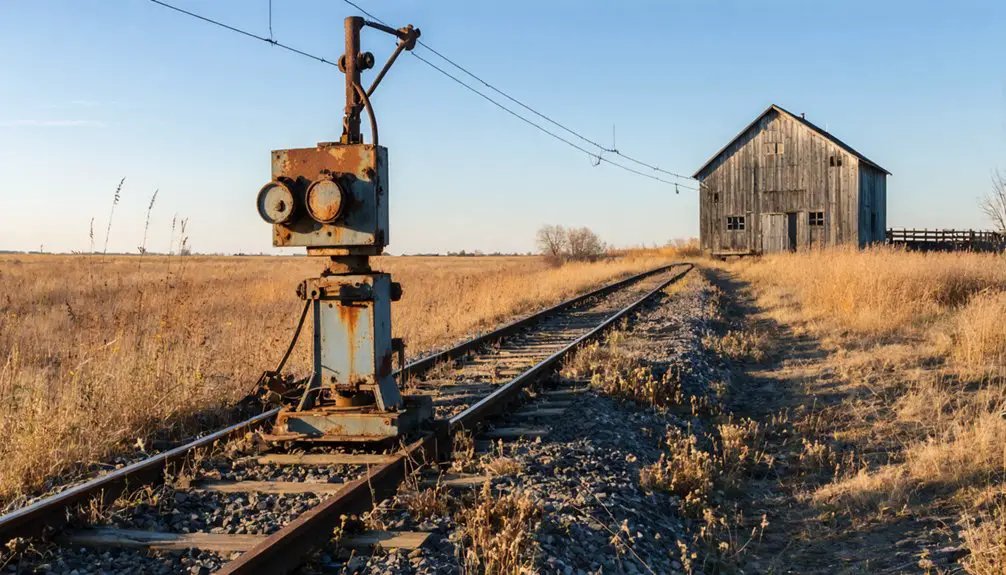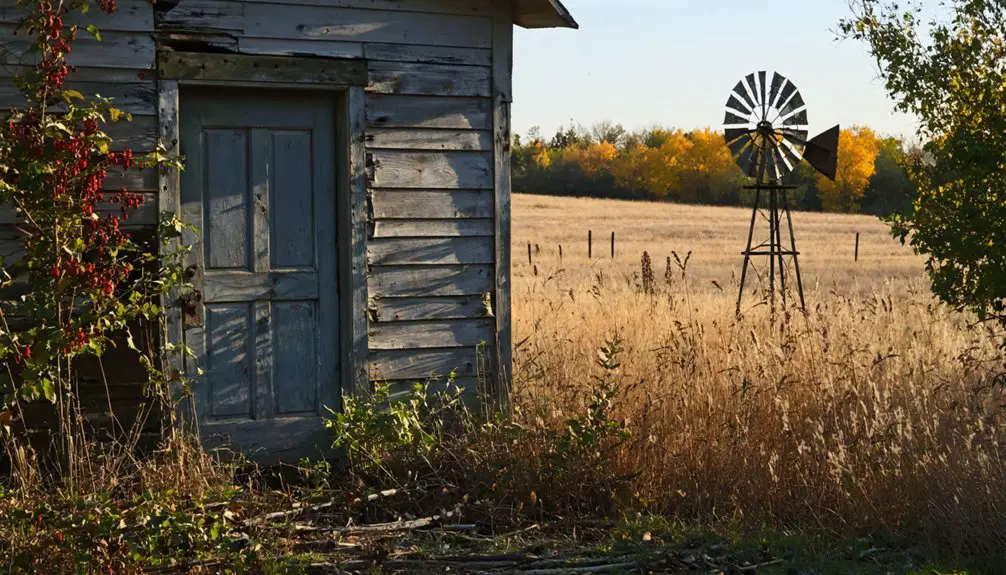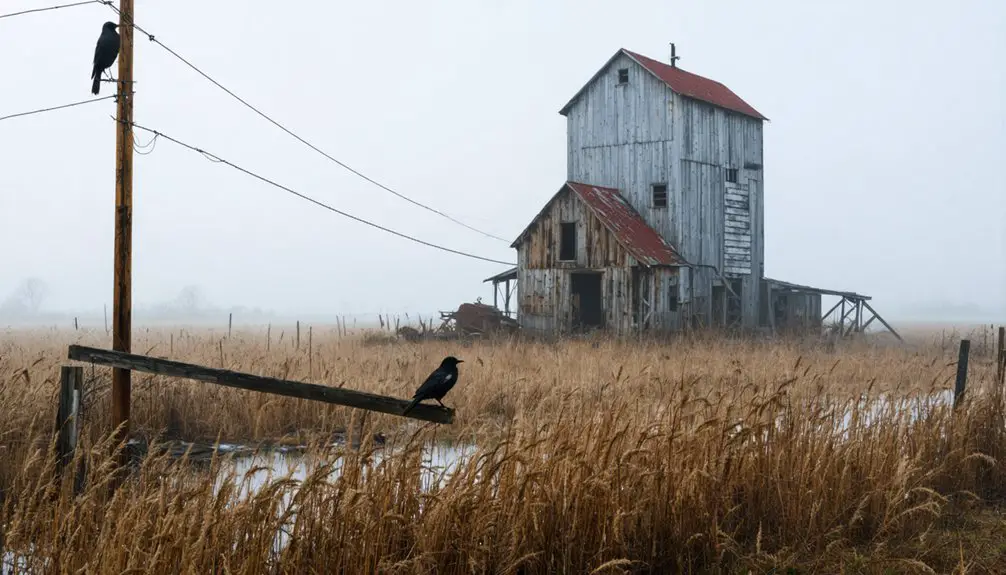You’ll discover Bruce, Minnesota was a bustling railroad town established in 1888 that completely vanished by the 1980s. Originally named Martin, the 16-block community thrived with hotels, shops, and an opera house along the Illinois Central Railroad. When the Sioux City & Northern Railroad bypassed Bruce for nearby Hills in 1890, the town’s decline began. Today, cornfields cover all traces of this once-promising settlement, but its story reveals fascinating lessons about frontier boom-and-bust cycles.
Key Takeaways
- Bruce, Minnesota was established in 1888 as a railroad town, named after lumberman A.C. Bruce who owned local land.
- The town’s decline began when the Sioux City & Northern Railroad bypassed it in 1890, favoring Hills 1.5 miles away.
- Bruce’s post office closed in 1936, marking the end of its formal existence as businesses and residents gradually departed.
- By the 1970s, demolition crews removed remaining structures, and railroad tracks were pulled up in 1982.
- The former town site has been completely converted to farmland, with no visible remnants of the original structures remaining.
The Birth of a Railroad Dream (1888)
When the Illinois Central Railroad established a new station in 1888, it sparked the creation of Bruce, Minnesota – a 16-block town that embodied the era’s railroad dreams.
The birth of Bruce, Minnesota in 1888 captures a moment when railroad stations transformed wilderness into thriving frontier communities.
You’d have found a bustling scene of pioneering spirit, with settlers quickly establishing a hotel, saloon, stores, and blacksmith shop to serve the growing community.
While the town was initially slated to be called “Martin,” the settlers chose to forge their own town identity by naming it after a railroad official, showing just how deeply the railways influenced local development.
The name’s significance was deepened by its historical leadership ties that connected to similar railway towns of the period.
The town’s significance grew as it became part of the first 46-mile track connecting Turtle Lake to Bruce, Wisconsin in 1884.
You can imagine the optimism of those first residents as they built their businesses along the tracks, believing they’d established a permanent home.
Little did they know their railroad dreams would soon face unexpected challenges from competing rail lines.
A Town Named Twice: From Martin to Bruce
Though the settlement initially bore the name “Martin,” you’ll find the town’s identity took a significant turn as it evolved into Bruce – a change that reflects the dynamic nature of frontier communities in Minnesota.
Census records show the presence of Bruce McMartin’s family in Minnesota, further connecting the area’s Scottish heritage to its naming history.
The cultural significance of this dual naming lies deep in the region’s history, with both Bruce and Martin families appearing in essential records and census documents of the era.
The shift likely stemmed from practical considerations, such as distinguishing the town from other similarly named settlements or honoring influential settlers.
Like the mixed-ancestry families of early Minnesota, the town’s residents often served as cultural bridges between different communities.
Local naming traditions often followed such patterns, particularly when railway developments or land ownership changes occurred.
You’ll discover traces of both names in historical archives, family histories, and obituaries, creating a rich tapestry of the town’s evolution through its documented past.
Early Days of Promise and Prosperity
During the promising years of 1884-1888, Bruce emerged as a carefully planned settlement of 16 city blocks, anchored by the Minneapolis, Sault Ste. Marie & Atlantic Railroad’s eastern expansion.
Named after lumberman A.C. Bruce, who owned local land and operated a logging camp, the town quickly attracted settlers seeking opportunity. Like the early days of Francis Bruce in 1842, the area showed great promise for development.
The vision of one lumberman, A.C. Bruce, transformed virgin forest into a frontier town brimming with pioneer spirit.
You’d have found a bustling hub of commerce, complete with multiple hotels including the MacArthur, which served as a popular stop for lumberjacks using the Soo Line Depot. The Bruce News-letter office became one of the town’s earliest established businesses.
The town’s cultural investment was evident in its 1904 opera house, while education flourished with a grade school that grew to employ six teachers by 1905.
Bruce’s early prosperity stemmed from railroad commerce and timber extraction, drawing diverse immigrants who established farms and businesses throughout the area.
Life Along the Illinois Central Railroad
If you’d visited Bruce’s Illinois Central Railroad station in its heyday, you’d have found it bustling with activity as trains carried passengers and freight between Chicago and points west.
The station served as the heart of Bruce’s commercial district, where travelers could find lodging at the hotel, refreshments at the saloon, or services at the blacksmith shop.
Regular train schedules dictated the rhythm of daily life, as local farmers brought their crops to market and merchants received their goods through the station’s loading dock. The railroad’s extensive network, known as the “Main Line of Mid-America”, connected communities like Bruce to major transportation routes from the Great Lakes to the Gulf of Mexico. The railroad’s development was shaped by key figures like Hon. Sidney Breese who initiated the central road plan in 1835.
Railroad Station Operations
Life along the Illinois Central Railroad revolved around its bustling stations, which served as vital community hubs throughout the late 19th and early 20th centuries.
You’d find these stations strategically placed at main street termini, where they’d handle both passenger and freight operations. Early structures like the Doane House weren’t just stations – they served as post offices, hotels, and community meeting spaces. The railroad’s extensive network grew to become the longest railroad in the world when completed in 1856.
As passenger service evolved, you’d see the railroad adapting to growing demands. By 1952, Chicago’s Central Station managed 19 daily trains, including premier services like the Panama Limited. The original depot was eventually moved 250 feet north to accommodate a new terminal as the community grew.
The stations also supported multiple transit modes, connecting streetcars with commuter trains. During the Civil War, you’d witness the railroad’s significant role in military transport, moving over 626,000 soldiers across its network.
Business Along The Tracks
Beyond the bustling platforms and ticket offices, Illinois Central Railroad stations sparked vibrant commercial districts that shaped local economies.
You’d have found Bruce’s early railroad commerce thriving with essential businesses – a hotel for weary travelers, a saloon for social gatherings, various stores for daily needs, and a blacksmith shop serving both settlers and rail operations.
But Bruce’s prosperity proved short-lived. When the Sioux City & Northern Railroad bypassed the town in 1890, you would’ve witnessed a dramatic business migration as merchants relocated to Hills, where the two rail lines intersected.
This pattern played out across the region – while single-line stops like Bruce initially flourished, it was the rail intersections that ultimately became the dominant commercial hubs, determining where sustainable business districts would emerge.
The Turning Point: When Rails Changed Course

Although Bruce initially thrived as a station on the Illinois Central Railroad line in 1888, its fate changed dramatically when the Sioux City and Northern Railroad extended its tracks from Iowa to South Dakota in 1890.
The railroad decisions created a critical junction point at Hills, just 1.5 miles east of Bruce, shifting the region’s transportation impact away from the young settlement.
A single railroad decision shifted an entire region’s destiny, as the new junction at Hills overshadowed neighboring Bruce.
You’ll find that this rail realignment triggered an exodus of businesses and residents from Bruce to Hills.
The town’s importance as a commercial hub quickly faded as the new rail intersection drew activity eastward.
It’s a stark reminder of how railroad routing could make or break frontier communities – in Bruce’s case, the bypass sealed its destiny, leading to its eventual transformation into farmland.
The Rise of Hills and Bruce’s Decline
When the Sioux City and Northern Railroad established its junction point in Hills during 1890, Bruce’s fate was sealed.
The railroad rivalry between the two towns sparked an immediate shift in economic dependency, with Hills’ strategic rail intersection drawing businesses and residents away from Bruce’s original settlement just 1.5 miles west.
You’d have witnessed a dramatic transformation as Bruce’s commercial establishments, including its hotel, saloon, and stores, relocated to take advantage of Hills’ superior transportation access.
Without rail connectivity, Bruce couldn’t sustain its local economy, and its population steadily declined.
Even though Bruce’s post office held on until 1936, the town’s destiny was clear.
Final Years as a Dying Prairie Town

The Bruce Post Office‘s closure in 1936 marked the final chapter of this prairie town’s formal existence, operating continuously since its founding in 1888.
You’ll find that after the post office shuttered, the remaining residents gradually departed as essential services and communication links disappeared.
The town’s physical remnants persisted until the early 1970s when demolition crews removed the last structures, converting the former townsite into what’s now a cornfield.
Post Office’s Last Stand
Despite serving as Bruce’s crucial communication hub since 1888, the local post office endured a gradual decline that mirrored the town’s fading fortunes.
You’d find this postal community hanging on through decades of depopulation after the railroad’s bypass favored nearby Hills. While businesses shuttered and residents departed, the post office remained Bruce’s final institutional anchor, preserving the town’s historical identity on federal maps until 1936.
Even as the building aged without upgrades, postal workers maintained critical communication services for scattered rural residents.
When the facility finally closed its doors, it marked Bruce’s official transformation from struggling settlement to ghost town.
Today, you’ll find only farmland where this last bastion of civilization once served its dwindling population.
Demolition Erases Town History
Following the post office’s closure in 1936, Bruce’s physical remnants steadily vanished from Minnesota’s prairie landscape.
You’d have seen the demolition impact accelerate through the early 1970s when crews tore down the last buildings, erasing decades of settlement history.
By 1982, even the Illinois Central Railroad tracks that once gave Bruce its purpose were pulled up, severing the final physical connection to its railroad town past.
The historical erasure was complete when farmers converted the former town site into cornfields.
Today, you won’t find any markers or monuments commemorating Bruce’s existence – just agricultural land where a prairie town once stood.
While written records and old aerial photos preserve Bruce’s story, its tangible heritage has been completely reclaimed by the prairie’s farming economy.
Gone Without a Trace: Modern Agricultural Land
Once a bustling community, Bruce, Minnesota now exists solely as farmland, primarily dedicated to corn cultivation.
Bruce’s streets and homes vanished beneath endless rows of corn, erasing all traces of its once-vibrant community life.
You’ll find no remnants of the original town structures or railroad tracks – they were completely removed by the early 1980s to make way for agricultural efficiency.
The transformation reflects broader economic shifts that began during the agricultural depression of the 1920s and 1930s, when farming income plummeted from $438 million to $155 million.
This financial pressure led to widespread land consolidation as smaller farms gave way to larger operations.
Today, modern farmers use mechanized equipment and advanced agricultural techniques on this former ghost town site.
The flat, obstacle-free land that was once Bruce proves excellent for contemporary farming methods, complete with irrigation systems and improved drainage for optimal crop production.
Legacy of a Lost Minnesota Settlement

While Bruce’s physical structures have vanished beneath the cornfields of Rock County, the town’s legacy endures as a compelling example of railroad-era settlement patterns in Minnesota.
You’ll find Bruce’s story woven into the broader tapestry of transportation alterations that shaped the region, as communities rose and fell based on railroad decisions. The town’s short-lived existence from 1888 to 1936 mirrors countless other settlements that experienced similar economic changes during America’s westward expansion.
Though no buildings remain at Bruce’s original site, its impact on local development lives on through historical records and aerial photographs.
The town’s relocation to Hills and eventual abandonment demonstrate how infrastructure choices could make or break frontier communities, serving as a reflection of the dynamic nature of Minnesota’s settlement period.
Lessons From Bruce’s Ghost Town Story
You’ll find Bruce’s cautionary tale centers on its fatal dependency on railroad economics, as the town’s entire existence hinged on being a rail stop without developing other industries or revenue streams.
The settlement’s rapid decline accelerated when the Sioux City and Northern Railroad bypassed it in favor of Hills, showing how nearby towns with better transportation links could quickly drain a community’s lifeblood.
Bruce’s complete disappearance demonstrates how a single-industry town can vanish when regional competition combines with an undiversified local economy.
Railroad Dependence Risks
The story of Bruce, Minnesota offers stark lessons about the risks of railroad dependence in early American settlements.
When you’re tied to a single rail line, you’re exposed to severe railroad vulnerabilities that can spell disaster for your community. Bruce learned this the hard way when the Sioux City and Northern Railroad bypassed the town by just 1.5 miles, choosing Hills instead.
The result was rapid economic isolation as businesses and residents relocated to follow the rail connection. Without diversified transportation options, Bruce couldn’t sustain itself.
The town’s eventual collapse – marked by the removal of Illinois Central tracks in 1982 – shows how external railroad companies’ decisions could devastate communities that lacked alternative economic foundations or transport networks.
Growth Without Economic Diversity
Despite initial signs of growth centered around its railroad station, Bruce’s economic development suffered from a critical lack of diversification that would ultimately seal its fate.
The town’s economic monoculture, heavily dependent on railroad commerce, left it vulnerable when transportation routes changed. You’ll find that Bruce’s limited business variety – just a hotel, saloon, stores, and blacksmith shop – couldn’t sustain long-term growth or attract substantial investment.
Without manufacturing, agricultural processing, or financial institutions, the town lacked the foundation for community sustainability.
When neighboring towns like Hills captured rail intersections and drew businesses away, Bruce couldn’t adapt. Its small labor pool and narrow economic base couldn’t support new industries or offset losses.
This singular focus on railroad-related activities proved to be Bruce’s undoing, offering a stark lesson in the risks of undiversified growth.
Local Competition’s Fatal Impact
While Bruce’s undiversified economy made it vulnerable, competition from neighboring Hills delivered the fatal blow to this fledgling railroad town.
You can trace the town’s demise to 1890, when the Sioux City and Northern Railroad created a new junction in Hills, just 1.5 miles east. This economic shift proved devastating as businesses and residents simply picked up and moved to the new rail hub.
You’ll find that local competition from Hills wasn’t just about attracting new growth – it literally absorbed Bruce’s existing commercial life.
The rail intersection gave Hills an insurmountable advantage, and Bruce couldn’t compete once bypassed by main rail traffic. Without alternative industries or transportation links, Bruce’s fate was sealed, leading to its complete disappearance into farmland by the 1980s.
Frequently Asked Questions
Were There Any Notable Crimes or Mysterious Events in Bruce’s History?
You won’t find any documented unsolved mysteries or criminal activities in Bruce’s history. The town’s decline was purely economic, caused by railroad bypasses rather than any notable incidents.
What Happened to the Cemetery and Burial Grounds of Bruce’s Residents?
You won’t find records of cemetery preservation or burial rituals in Bruce today. The burial grounds were likely absorbed into farmland when the town died, with remains either destroyed or relocated without documentation.
Did Any Famous People Ever Visit or Stay in Bruce?
Like a forgotten footnote in history’s pages, you won’t find any documented famous visitors or celebrity sightings in Bruce. Historical records show no evidence of notable figures ever staying in this short-lived town.
What Was the Highest Recorded Population of Bruce During Its Existence?
You won’t find official historical records showing Bruce’s highest population. Based on comparable ghost towns and limited population growth patterns, estimates suggest it likely never exceeded 200 residents.
Were There Any Schools or Churches Established During Bruce’s Brief Existence?
Like a town without footprints in time, you won’t find any school legacy or church influence in Bruce’s story. No schools or churches were ever established during its fleeting existence.
References
- https://en.wikipedia.org/wiki/Bruce
- https://thievesriver.com/blogs/articles/ghost-towns-in-minnesota
- https://www.cbsnews.com/minnesota/news/forestville-southern-minnesota-ghost-town-still-attracting-summer-visitors/
- https://kids.kiddle.co/Bruce
- https://commons.wikimedia.org/wiki/File:Street_scence
- https://www3.mnhs.org/mnopedia/search/index/thing/minneapolis-st-paul-and-sault-ste-marie-railroad-soo-line
- https://rockcountyhistorical.com/communities/vanished-towns/
- https://www.angelfire.com/mn/thursdaynighthikes/minnrrs175.html
- https://www3.mnhs.org/mnopedia/search/index/moving-through-minnesota-transportation-land-lakes
- https://www.myheritage.com/names/bruce_mcmartin



